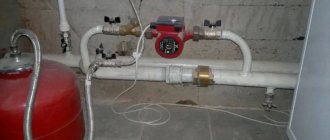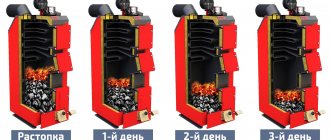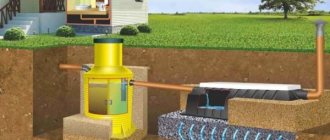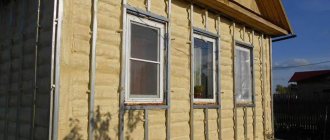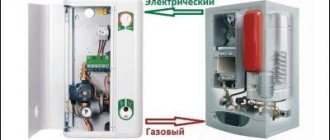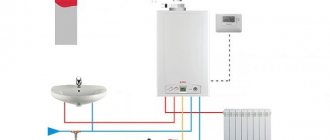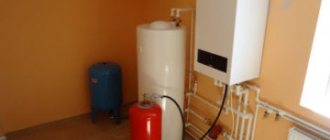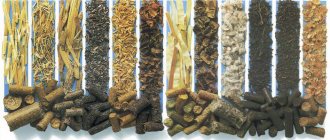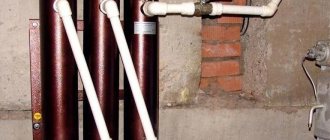Properly choosing boilers for heating a private home is necessary for installing an autonomous system. It is heating equipment that will provide housing with heat and hot water. It will create the microclimate necessary for human habitation. In addition, it will work flawlessly. It is so?
We will tell you how to buy a boiler that will meet your requirements and wishes. We have analyzed all the criteria that you should pay attention to when looking through catalogs of online stores or an assortment of specialized retail outlets. Problems that you may encounter before and after purchase are listed.
Basic criteria for choosing boilers
Hundreds of foreign and domestic manufacturers offer thousands of models of heating equipment. It is not easy for an unprepared buyer to navigate all this variety of products. I want it to be cheaper and the quality to be high.
All heating boilers differ in the type of fuel and are divided into the following categories:
- solid fuel (processing firewood, peat, pellets, coal);
- liquid fuel (units running on diesel fuel);
- gas (regular and condensing);
- electrical (requiring electricity supply);
- universal (using either gas or electricity).
Before choosing an option, it would be a good idea to do a little analysis and find out which energy carrier is profitable to use in your region. Then you need to decide how safe, reliable and comfortable the boiler should be in terms of every penny invested in it.
You need to choose one or another type of heating equipment after first familiarizing yourself with the advantages and disadvantages of each of them.
In order not to make a mistake and not waste your hard-earned money, you need to carefully consider the process of choosing equipment. To do this, it is necessary to take into account a number of nuances that significantly affect the final result.
When choosing a boiler you should:
- understand in detail the advantages and disadvantages of each type of boiler;
- calculate the optimal heating power for your home;
- decide on the number of circuits;
- choose the location where the equipment will subsequently be placed.
The maximum permissible dimensions and weight depend on the future location of the boiler. After all, for a small room it is not advisable to choose a heavy cast iron unit.
The choice of heating equipment must be approached responsibly. This is the only way to buy high-quality equipment that will last for many years.
Universal heat generators
Heat sources that can use several types of solid fuel can be considered universal: firewood, coal, wood chips, pellets. The process takes place in one chamber without the use of serious automation equipment. True, burning pellets in a simple way, in a firebox, will not give the same heat transfer that can be obtained with a pellet burner. In the installations of some manufacturers, this possibility is provided: a torch pellet burner is built into the loading door or a special opening on the front panel.
But in this case, it will become impossible to heat with wood, that is, a universal boiler can operate on different fuels after some design modifications. In the same way, it will take time and stop the process to replace a gas burner with a pellet burner and vice versa. Such a replacement is possible in some products from foreign manufacturers.
All multi-fuel heat generators are attractive due to their main advantage - generating heat from several types of energy resources. This makes the homeowner independent from many external shocks associated with the rise in price of a particular energy source. At the same time, multi-fuel heating boilers have some disadvantages:
- complexity and high cost;
- large overall dimensions and weight;
- low efficiency indicator, efficiency is 2-3% lower than in individual units;
- dependence on the availability of electricity.
Rules for calculating equipment power
It’s worth remembering right away that the desire to save money on designing a heating system and performing thermal calculations in most cases backfires on the customer. If you think through everything carefully and trust a highly qualified specialist, then the cost of the boiler, radiators and other equipment will be much cheaper.
The power of the heating boiler is selected to calculate the distribution of approximately 0.1 kW per m2 of living space
To approximate the power of heating equipment required to heat a building and provide hot water supply, you can use special design standards.
It is also imperative to take into account:
- the number of people who will live in the house;
- building materials used for housing construction;
- climate zone;
- number of windows and doors;
- number of floors and other factors.
The opinion that the boiler power is selected at the rate of 0.1 kW per square meter is quite common. But thanks to modern building materials and innovative engineering equipment, heat losses can be significantly lower and, accordingly, the performance of heating equipment can be higher.
Comparison of fuel costs and operating costs
According to surveys and practice, the top three most important selection criteria for most buyers include gas consumption. For gas, some liquid fuel and solid fuel boilers, the maximum flow rate is indicated in the characteristics. But besides the fact that this is just the maximum possible indicator, it is difficult to deduce from it the degree of boiler efficiency, because fuel consumption also depends on the parameters of the house, correctly selected power, operating conditions of the boiler, etc.
In general, it is impossible to calculate the actual consumption of any type of fuel in a generalized form. However, approximately - quite realistic. The difference between heating costs is noticeable, which makes the picture clearer.
Natural gas . The normal calorific value of natural gas is 9.3-10 kW per m3 (the minimum allowable by GOST 5542-2014 is 8.84 kW/m3), this means that for 1 kW of thermal power of a gas boiler you need 0.1-0.108 m3 of natural gas gas For the 1st half of 2022, 1 m3 of main gas in the Moscow region is 5.92 rubles/m3 or 0.59-0.64 rubles. for each kW of boiler thermal power.
The generally accepted norm for an average uninsulated or weakly insulated house with a ceiling height of 2.7 m is: 1 kW for every 10 m2 of heated area.
The technical characteristics of any gas boiler indicate the maximum gas consumption, from here you can calculate the maximum possible heating bill. Using the example of BAXI SLIM 1.150 i (power 14.9 kW), the maximum natural gas consumption is 1.74 m3/hour:
- Per day – 24 (hours) * 1.74 (m3/hour) = 41.76 m3. In value terms – 41.76 (m3) * 5.92 (tariff for Moscow region, rub.) = 247.2 rubles/day.
- Per month – 30 (days) * 41.76 (daily consumption, m3) = 1,252.8 m3. In value terms – 1,252.8 (cubic meters) * 5.92 (tariff, rub.) = 7,416.6 rub./month.
- For the heating season (suppose from October 15 to March 31) - 136 (days) * 41.76 (m3) = 5,679.4 cubic meters. In value terms – 5,679.4 * 5.92 = 33,621.8 rubles/season.
It is important to understand that in practice the boiler does not operate 24/7 at full capacity: in this case, the wear of its elements accelerates many times over. A gas boiler correctly selected in terms of power (taking into account the area, heat loss of the house and a small power reserve of 10-20%) consumes only 50-70% of the values calculated above for the maximum possible operating mode of the boiler. Consider how many kW is needed specifically for your home.
How to calculate how much gas a gas boiler consumes All calculation methods and online calculator
Electricity . With electricity, calculations are much simpler: the efficiency of all modern electric boilers is 99%, that is, at maximum heating output, a 15 kW boiler unit will consume 15.15 kW of electricity. For the 1st half of 2022, 1 kW of electricity for a private house in the Moscow region costs 4.01 rubles. or 4.05 rub. for each kW of boiler thermal power.
The maximum possible heating bill using the example of any modern 15 kW electric boiler:
- Per day – 24 (hours) * 15.15 (kW) = 363.6 kW. In value terms – 363.6 (kW) * 4.01 (rubles per 1 kWh) = 1,458 rubles/day.
- 30 (days) * 363.6 (kW) = 10,908 kW per month In value terms – 43,741 rubles/month.
- For the heating season (suppose from October 15 to March 31) - 136 (days) * 363.6 (kW) = 49,449.6 kW. In value terms – 198,292.9 rubles/season.
Let us remind you that this is the maximum possible, and not the actual consumption.
How to calculate how much electricity an electric boiler consumes Calculation based on house parameters, examples of electricity bills
Firewood . The calorific value of ordinary freshly cut or recently cut firewood, the humidity of which is w ≈ 60–50%, is on average 1,800–2,000 kW/m3. This means that to obtain 1 kW of thermal energy, 0.0005-0.00056 m3 of firewood is needed. The cost of 1 cubic meter of freshly cut birch, alder or oak firewood is 1,600-1,800 rubles. or 0.8-1.01 rub. for each kW of boiler thermal power.
Coal . The calorific value of the most common coal is (w ≈ 7–15%), on average 7.5-8 kW/kg. This means that to obtain 1 kW of thermal energy, 0.133-0.125 kg of coal is needed. The cost of 1 ton of coal is 6,000 rubles. or 0.75-0.8 rub. for each kW of boiler thermal power.
Of course, it would be correct to make an adjustment for the efficiency of solid fuel boilers, which is on average 80%. For a more realistic picture, it is advisable to multiply the obtained cost indicators for 1 kW by 1.2 (80% efficiency).
Diesel fuel and fuel oil. Without going into details, liquid fuel boilers, when burning 1 liter of diesel fuel, waste oil or fuel oil, produce 10 kW of thermal energy. That is, 1 kW of thermal power accounts for 0.1 liters of fuel. The cost of Euro 4 diesel fuel is 35-40 rubles/l or 3.5-4 rubles. for each kW of thermal power. The cost of used oil in Moscow Region is on average 8-15 rubles/l or 0.8-1.5 rubles for each kW of thermal power.
Maximum consumption of a diesel boiler (l) – Boiler power, kW / 10, hence, having a 15 kW boiler:
- Per day – 24 (hours) * 1 (l) = 24 l. In value terms – 24 (l) * 35 (rubles per 1 l) = 840 rubles/day.
- Per month – 30 (days) * 24 (l) = 720 l. In value terms – 25,200 rubles/month.
- For the heating season (suppose from October 15 to March 31) - 136 (days) * 24 (l) = 3,264 l. In value terms – 114,240 rubles/season.
It is important to understand that these figures are given for continuous operation at full power, which is quite rare. Typically, boilers operate no more than 1/3 of the time of day, so these calculations can be safely reduced by 2-3 times. Also, liquid fuel boilers are usually purchased if there is a source for purchasing fuel at lower than average market prices.
| Type of fuel | Calorific value, kW.h/m3 (kg, t, l) | Cost of fuel unit, rub. | Cost of 1 kW of thermal energy, rub. |
| Natural gas | 9,3-10 | 5,92 | 0,59-0,64 |
| Electricity | 1 | 4,01 | 4,05 |
| Firewood | 1 800-2 000 | 1 600 | 0,8-1,01 |
| Coal | 7,5-8 | 6 000 | 0,75-0,8 |
| Diesel fuel | 11-11,3 | 35 | 3,5-4,0 |
| Working off | 11-11,3 | 8 | 0,8-1,5 |
Features of single- and double-circuit boilers
When thinking about how to choose the right heating boiler for your home, special attention should be paid to such a characteristic as the number of circuits. Single-circuit technology is intended exclusively for heating the coolant circulating through heating pipes.
A single-circuit boiler is designed to serve only one system: either hot water supply or heating. If it is not possible to install a double-circuit unit, it is permissible to use no more than two boilers in one boiler room, regardless of their floor or wall-mounted design
In this case, to heat tap water you will have to additionally install a boiler. Yes, a single-circuit boiler is convenient, but the disadvantage of this solution is its high cost - you will have to buy not only heating equipment, but also a boiler. Moreover, both devices will take up a lot of space.
As for the double-circuit boiler, here the heating equipment and water heater are assembled into a single structure. Thanks to this structure, you can solve two problems at once, while purchasing only one unit.
In addition, in the absence of hot water, the coolant can be redirected to the second circuit and used alternately - to heat the house and to provide hot water supply.
Operating principle of single-circuit equipment
Single-circuit heating equipment is most often used by owners of luxury country houses. In essence, a single-circuit boiler is the same water heater, but supplies water to the heating system.
The operating principle of this type of equipment is based on burning fuel in a special compartment and heating the liquid. The heating main is connected to the outlet where the hot coolant enters. Next, the water begins to circulate through the pipes and heat the rooms.
The final stage of circulation is the flow of waste coolant back into the boiler through the inlet pipeline.
If you do not need to provide hot water supply, then it is better to give preference to single-circuit boilers
The cost of a single-circuit boiler may be more than a double-circuit system. Even despite less functionality, this type of equipment is less expensive to install, easier to operate and more energy efficient.
Single-circuit equipment is suitable for those buyers who want to spend money once and buy reliable equipment that does not require special care. This type of boiler will be the ideal and only right choice when there is no need for hot water supply in the house.
Design specifics of a dual-circuit unit
A double-circuit boiler is a system where, in addition to the primary heat exchanger, there is an additional one designed to heat water and then supply it to the water supply system. The movement of the coolant is controlled using a three-way valve. It directs the heated water either to the DHW circuit or to the heating system.
It should be noted that in the first case, the coolant will be supplied only if the hot water tap has been opened. The peculiarity of such heating equipment is that while the tap responsible for supplying hot water is open, the system does not work.
If you have a large family and some of its members like to take long showers, then the rooms may become cool. Manufacturers solve this problem by installing a storage water heater in their boilers.
The disadvantages of the double-circuit boiler design include the need for careful and attentive maintenance. This is due to the fact that the secondary heat exchanger can become overgrown due to the use of water containing organic and mineral particles suspended in it, and the small diameter of the pipes.
If you plan to actively consume hot water, then installing a double-circuit boiler is not the best solution. After all, then the house will not be heated well. You should only think about installing this system in a small house or apartment, where there is not enough space to organize a full-fledged boiler room.
Popular models
Keep in mind! It is easy to find suitable heating equipment on the domestic market.
The main thing is to decide in advance on the desired parameters and consider the model range in detail.
Models of small and medium thermal power up to 30 kW
TOP-5 rating of models with average power in terms of price and quality ratio.
Teplodar Kupper OVK 18 18 kW
Powerful equipment that is perfect for installation in a small room.
A combined single-circuit unit, presented in a compact housing that will not take up much space in the room.
The presence of a water-tube heat exchanger can significantly improve heat removal and increase the efficiency of the device, which are the main advantages of this model.
Specifications:
- maximum thermal power – 18 kW;
- heat exchanger material – steel;
- fuel – natural gas, coal, firewood, pellets;
- coolant temperature – 60-80 °C;
- control type – mechanical.
Advantages
- steel primary heat exchanger;
- possibility of connecting external control;
- presence of a hob;
- versatility of use;
- Convenient floor installation.
Flaws
- chimney elements will have to be purchased separately;
- lack of draft regulator included;
- complicated operating instructions.
Teplodar Kupper PRO 28 28 kW
An impressive new product, with which you no longer have to think about how to quickly heat the room.
A single-circuit model from the middle price range, which successfully implements a long-burning mode when working on coal and wood.
The device also provides the ability to install a pellet or gas burner - this allows for complete automation of the process, relieving the user of the need to constantly monitor the situation.
Specifications:
- maximum thermal power – 28 kW;
- heat exchanger material – steel;
- fuel – natural gas, coal, coal and wood briquettes, firewood, pellets;
- coolant temperature – 60-95 °C;
- control type – mechanical.
Advantages
- pre-installed thermometer;
- energy independence of equipment;
- long warranty period;
- the presence of a heating element to maintain temperature;
- extended equipment.
Flaws
- weight and dimensions of the structure;
- fast cooling;
- expensive repairs.
ACV Delta Pro S 25 26 kW
A unique model that can pleasantly surprise with its wide functionality and attractive price.
Double-circuit combi boiler designed for floor installation, ideal for both domestic and industrial purposes.
The device is distinguished by the presence of a well-thought-out system of protection against high pressure and overheating, which guarantees absolute safety of operation.
Specifications:
- maximum thermal power – 26 kW;
- heat exchanger material – stainless steel;
- fuel – natural gas, liquefied gas, diesel fuel;
- coolant temperature – 60-90 °C;
- control type – electronic.
Advantages
- power-on indication;
- presence of a thermometer and pressure gauge;
- possibility of connecting external control;
- presence of a safety valve;
- built-in boiler.
Flaws
- the burner is purchased separately;
- high cost of the model;
- It is better to invite a professional for installation.
Protherm Bizon 30 NL 27.1 kW
A highly efficient device that does not require special skills or knowledge to operate.
Single-circuit combined convection type unit, equipped with a thermometer and pressure gauge.
A nice addition was the detailed overheating protection system.
Convenience, reliability, high level of safety - the design has everything for comfortable work.
Specifications:
- maximum thermal power – 27.1 kW;
- heat exchanger material – cast iron;
- fuel – natural gas, liquefied gas, diesel fuel;
- coolant temperature – 30-90 °C;
- control type – electronic.
Advantages
- intuitive control system;
- no need for special maintenance;
- long warranty period;
- high technical characteristics;
- unobtrusive design.
Flaws
- The delivery package does not include an inflatable burner;
- slight noise during operation;
- easily dirty snow-white body.
Buderus Logano G125 WS-25 25 kW
An easy-to-use unit designed for long-term operation without breakdowns.
High-performance heating boiler, in the manufacture of which the most modern technologies were used.
The low-temperature device can be combined with gas and diesel fuel-powered fan burners.
High corrosion resistance is ensured by the use of special gray cast iron.
Specifications:
- maximum thermal power – 25 kW;
- heat exchanger material – cast iron;
- fuel – natural gas, liquefied gas, diesel fuel;
- coolant temperature – 50-90 °C;
- control type – electronic.
Advantages
- large selection of additional equipment;
- water-cooled combustion chamber;
- excellent quality of materials and workmanship;
- reasonable cost;
- good equipment.
Flaws
- no control panel provided;
- device dimensions;
- Questions for the instruction manual.
High power models from 30 kW
The best high-power models according to customer reviews and ratings.
Teplodar Kupper PRO 42 42 kW
The most powerful combined type unit, characterized by ease of maintenance and use.
One of the best-selling models on the domestic market, which has optimal thermal power and a basic mechanical control system.
To maintain the temperature for a long time, the manufacturer has added a high-power heating element to the equipment.
The combustion chamber in the device is open.
Specifications:
- maximum thermal power – 42 kW;
- heat exchanger material – steel;
- fuel – natural gas, coal, coal briquettes, firewood, pellets;
- coolant temperature – 95 °C;
- control type – mechanical.
Advantages
- ease of maintenance;
- sophisticated security system;
- clear instructions included;
- versatility of use;
- acceptable price.
Flaws
- device weight;
- Before installation, you must carefully study the instructions;
- dimensions.
Sime 1R6 FREEST 64.8 kW
A high-tech design that will be the best option for people living in private homes.
A classic heating device with an open combustion chamber, a basic electronic control system and a built-in thermometer.
The unit has high thermal power, so it is perfect for installation in large houses.
Specifications:
- maximum thermal power – 64.8 kW;
- heat exchanger material – cast iron;
- fuel – natural gas, liquefied gas, diesel fuel;
- coolant temperature – 60-90 °C;
- control type – electronic.
Advantages
- simple control system;
- reasonable cost of the device;
- expanded functionality;
- sufficient heated area;
- significant budget savings.
Flaws
- the burner will have to be purchased separately;
- noisy operation of the device;
- specific smell when first used.
Ferroli Atlas Evo 47
A superbly designed device that has absolutely everything for comfortable use.
Highly reliable and energy efficient equipment, presented in a compact case that does not take up much space.
The unit is distinguished by its operation with a low level of sound power, which means that it will definitely not cause any discomfort.
Specifications:
- maximum thermal power – 47 kW;
- heat exchanger material – steel;
- fuel – natural gas, coal, firewood, pellets;
- coolant temperature – 95 °C;
- control type – electronic.
Advantages
- excellent frost protection;
- preset display;
- closed combustion chamber;
- possibility of connecting external control;
- affordable price.
Flaws
- design for everyone;
- rather complicated instruction manual;
- Some items will have to be purchased separately.
Sime 1R7 FREEST 74 kW
A universal floor-standing unit with high technical characteristics.
Standard single-circuit model with an atmospheric combustion chamber, designed for floor installation.
The device can operate with a single-stage burner, but it is also possible to connect a climate regulator.
The warranty period for the device is one year.
Specifications:
- maximum thermal power – 74 kW;
- heat exchanger material – cast iron;
- fuel – natural gas, liquefied gas, diesel fuel;
- coolant temperature – 60-90 °C;
- control type – electronic.
Advantages
- possibility of connecting external control;
- high-quality assembly and excellent materials;
- simple and unobtrusive design;
- almost silent operation;
- clear instruction manual.
Flaws
- The delivery set does not include a burner;
- short warranty period;
- impressive design dimensions.
Lamborghini Calor EL DB DN EVO 32
An ultra-modern device, which is a prominent representative of the economical line.
Floor-mounted combination heating boiler with an ultra-modern design.
The device body is assembled from high-strength cast iron elements with a special arrangement of ribs, which ensures high efficiency and significant energy savings.
Specifications:
- maximum thermal power – 32 kW;
- heat exchanger material – cast iron;
- fuel – diesel fuel, natural and liquefied gas, waste oil, fuel oil;
- coolant temperature – 95 °C;
- control type – electronic.
Advantages
- high performance;
- innovative protection system;
- intuitive control system;
- simplified installation of the structure;
- enhanced thermal insulation.
Flaws
- expensive equipment repairs;
- increased sound power level;
- meager equipment.
Selecting a location for heating equipment
All types of heating boilers are produced mainly in a floor-standing version, electric in a wall-mounted version, and gas in both a wall-mounted and a floor-mounted version. The latest variation is best installed in a spacious separate room. Such heating equipment is characterized by great power and massiveness.
A wall-mounted boiler will be an ideal solution for small-sized houses, where every square meter counts
And due to the fact that the weight of floor-standing boilers is not limited in any way, manufacturers install a cast-iron heat exchanger in it, which is much more reliable than a steel one.
Wall-mounted heating equipment is compact in size and fairly light in weight. But this type of boiler is limited in power. This minus is especially relevant for dual-circuit systems - the performance of the heating circuits will be quite low.
You should choose wall-mounted boilers only if the heated area does not exceed 200 m2 and the hot water consumption is no more than 14 l/min. If the needs are greater, then it is better to give preference to the floor-mounted variation of heating equipment.
It should be noted that many buyers, regardless of the size of their living space, prefer floor-mounted systems that are equipped with a cast-iron heat exchanger. After all, such devices are less demanding on the quality of power supply.
Alternative methods of heating a private house
In fact, there are only two main alternatives to water heating using a boiler, and each of them is not suitable in all cases.
Electric convectors, radiators, infrared heaters . The most famous and widespread alternative option, much cheaper than organizing a water heating system. Often used in conjunction with heated floors. However, it is better and more economical to use convectors and other electric heaters only under certain conditions:
- the heated area of a private house is less than 80 m2 (only in this case can you have adequate amounts in your electricity bills, up to 5-8 thousand rubles during the heating season);
- it is planned to purchase relatively expensive models with precise electronic control and the ability to combine devices into one system through a common thermostat or application;
- temporary residence in a house, when the low initial cost of organizing a heating system (compared to water) will pay off higher operating costs for a long time.
In addition, it is important to calculate the total peak power of the heaters and reserve for other electrical appliances, since when consuming more than 6 kW, a three-phase (380 V) network is required.
Heat pump and air recovery . A modern system used in recent, often large and expensive houses. Usually it is capable of providing a temperature of no more than 18-20°C, so in addition it is supplemented with several electric heaters. Its meaning is to use the thermal energy of the earth, which at a certain depth maintains a positive temperature in any season of the year. Operating costs for such a system are low, but the complexity of its organization and the cost of equipment are not feasible for everyone:
- a good heat pump costs on average 300-500 thousand rubles, its installation can cost up to half the cost of the pump itself;
- a recuperator that provides ventilation and heats the incoming air - 30-60 thousand rubles, and usually more than one is needed;
- The energy produced by a heat pump is realized through a water heating circuit or heated floors, which is also a considerable expense.
When deciding to install a heat pump, it is necessary to calculate its payback, which, due to the many individual characteristics of the house and the situation as a whole, cannot be calculated using a general formula. In Russian conditions, such a system usually pays for itself in 7-12 years.
Subtleties of using boilers
The vast majority of boiler models require electricity to function properly. The only exception is solid fuel heating equipment that burns coal or wood. Such devices can work autonomously.
Why is electricity needed? Current is required for the operation of the boiler system automation and its pumps. Therefore, a good solution would be to order an electric generator along with the heating equipment. This solution is especially relevant for those regions where the power is often turned off.
When organizing a boiler room, special attention should be paid to the chimney to ensure proper operation of the equipment and safety during its use
Regardless of the type of boiler used, the manufacturer does everything possible to ensure that the operation of its equipment is as safe as possible.
Therefore, almost any modern model of heating equipment is equipped with the following protection systems:
- a sensor that detects the presence or absence of a flame;
- traction control sensor;
- a device that will stop the operation of the boiler if the pressure in the gas pipeline drops below the permissible level;
- a device that turns off the boiler in the event of a lack of electricity;
- a system that protects equipment from overheating;
- a sensor that stops the operation of heating equipment in the event of a decrease in the volume of coolant.
All the details listed above are the bare minimum that will protect the boiler from breakdowns and the home itself from fire.
As for the location of the equipment, certain models of boilers, the boiler power does not exceed 100 kW, can be installed directly in the kitchen.
Other types of heating equipment must be placed in a specially equipped room of a certain cubic capacity, with a thoughtful and well-designed ventilation system, with fire safety devices, etc.
The organization of a boiler room must be approached with all responsibility and must comply with all recommendations of specialists, as well as fire safety standards
The most commonly used boilers in the CIS countries at present are gas boilers. This demand is explained by the low cost of this energy carrier, as well as the reliability and durability of boilers of this type. But due to regional characteristics, gas heating equipment is not always the most optimal and profitable solution.
You need to choose heating equipment depending on your personal wishes and needs, the size of your living space and the availability of energy.
Economical fuel consumption and reduction in equipment maintenance costs are an important component of choosing the optimal unit for an independent heating system. The rules for organizing energy-saving heating are given in our recommended article.
Reviews
Reviews about combination boilers are mostly positive. In order to fully realize their advantages, it is necessary to choose the right type of structure.
In some regions, electricity is more expensive than gas, so you need to choose a boiler that uses gas as the main fuel.
Solid-state coolants can be used as secondary fuel if conditions permit.
Negative reviews are also present, but are mainly related to incorrect selection or violation of the rules and operating conditions.
